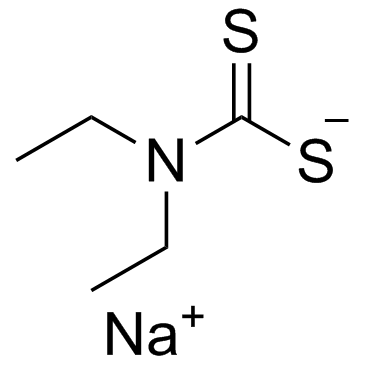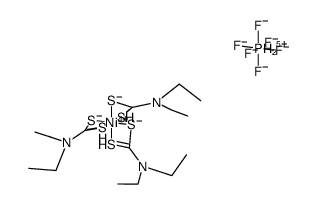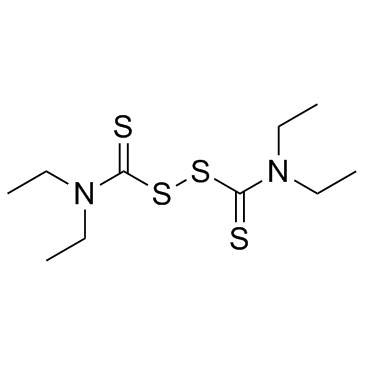14267-17-5
| Name | Nickel Diethyldithiocarbamate |
|---|---|
| Synonyms |
N,N-diethylcarbamodithioate,nickel(2+)
Nickel Diethyldithiocarbamate Diethyldithiocarbamic Acid Nickel Salt Carbamodithioic acid, N,N-diethyl-, nickel(2+) salt (2:1) Nickel(2+) bis(diethylcarbamodithioate) |
| Boiling Point | 176.4ºC at 760mmHg |
|---|---|
| Molecular Formula | C10H20N2NiS4 |
| Molecular Weight | 355.233 |
| Flash Point | 60.5ºC |
| Exact Mass | 353.986267 |
| PSA | 121.26000 |
| LogP | 3.62120 |
|
Section I.Chemical Product and Company Identification Chemical Name Nickel Diethyldithiocarbamate Portland OR SynonymNickel, bis(N,N-diethylcarbamodithioato- kappaS,kappaS')-, (SP-4-1)- (CA INDEX NAME); Diethyldithiocarbamic Acid Nickel Salt Chemical FormulaC10H20N2NiS4
14267-17-5 CAS Number Section II.Composition and Information on Ingredients Chemical NameCAS Number Percent (%)TLV/PELToxicology Data Nickel Diethyldithiocarbamate14267-17-5Min. 97.0 (T)This chemical is classified as aNot available. carcinogen. There is no acceptable exposure limit for a carcinogen. Section III. Hazards Identification Harmful if ingested or inhaled. Minimize exposure to this material. Severe overexposure can result in injury or death. Acute Health Effects Skin contact may result in sensitization. Always cover all exposed skin with an impermeable layer and use proper eye protection. A OSHA/MSHA approved dust and vapor respirator is required when working with this material. Follow safe industrial hygiene practices and always wear proper protective equipment when handling this compound. CARCINOGENIC EFFECTS : Carcinogenic by RTECS criteria. Chronic Health Effects MUTAGENIC EFFECTS : Not available. TERATOGENIC EFFECTS : Not available. DEVELOPMENTAL TOXICITY: Not available. Repeated or prolonged exposure to this compound is not known to aggravate existing medical conditions. Section IV.First Aid Measures Check for and remove any contact lenses. In case of contact, immediately flush eyes with plenty of water for at least 15 Eye Contact minutes. Get medical attention. Skin ContactIn case of contact, immediately flush skin with plenty of water. Remove contaminated clothing and shoes. Wash clothing before reuse. Thoroughly clean shoes before reuse. Get medical attention. InhalationIf the victim is not breathing, perform mouth-to-mouth resuscitation. Loosen tight clothing such as a collar, tie, belt or waistband. If breathing is difficult, oxygen can be administered. Seek medical attention if respiration problems do not improve. IngestionINDUCE VOMITING by sticking finger in throat. Lower the head so that the vomit will not reenter the mouth and throat. Loosen tight clothing such as a collar, tie, belt or waistband. If the victim is not breathing, perform mouth-to-mouth resuscitation. Examine the lips and mouth to ascertain whether the tissues are damaged, a possible indication that the toxic material was ingested; the absence of such signs, however, is not conclusive. Section V.Fire and Explosion Data Not available. Auto-Ignition FlammabilityMay be combustible at high temperature. Flammable LimitsNot available. Flash Points267°C (512.6°F) Combustion ProductsThese products are toxic carbon oxides (CO, CO2), nitrogen oxides (NO, NO2), sulfur oxides (SO2, SO3...). Some metallic oxides. Fire HazardsNot available. Risks of explosion of the product in presence of mechanical impact: Not available. Explosion Hazards Risks of explosion of the product in presence of static discharge: Not available. Fire Fighting MediaSMALL FIRE: Use DRY chemical powder. and InstructionsLARGE FIRE: Use water spray, fog or foam. DO NOT use water jet. Consult with local fire authorities before attempting large scale fire-fighting operations. Continued on Next Page Nickel Diethyldithiocarbamate Section VI.Accidental Release Measures Spill CleanupHarmful material. This material is a skin and respiratory sensitizer. Carcinogenic material. Use a shovel to put the material into a convenient waste disposal container. Consult federal, state, and/or local authorities for Instructions assistance on disposal. Section VII. Handling and Storage Handling and StorageHARMFUL. SKIN AND RESPIRATORY SENSITIZER. CARCINOGEN. Keep away from heat. Mechanical exhaust required. When not in use, tightly seal the container and store in a dry, cool place. Avoid excessive heat and light. Do not breathe Information dust. Always store away from incompatible compounds such as oxidizing agents. Section VIII. Exposure Controls/Personal Protection Use process enclosures, local exhaust ventilation, or other engineering controls to keep airborne levels below recommended Engineering Controls exposure limits. If user operations generate dust, fume or mist, use ventilation to keep exposure to airborne contaminants below the exposure limit. Personal ProtectionSplash goggles. Lab coat. Dust respirator. Boots. Gloves. Suggested protective clothing might not be sufficient; consult a specialist BEFORE handling this product. Be sure to use a MSHA/NIOSH approved respirator or equivalent. Exposure LimitsThis chemical is classified as a carcinogen. There is no acceptable exposure limit for a carcinogen. Section IX. Physical and Chemical Properties Solid. (Crystal ~ powder,Solubility Physical state @ 20°CSoluble in pyridine. deep yellow green ~ deep green.) Not available. Specific Gravity Molecular Weight355.23Partition Coefficient Not available. Boiling PointNot available.Vapor PressureNot applicable. Not available.Not available. Melting PointVapor Density Refractive IndexNot available.VolatilityNot available. Not available.Not available. Critical TemperatureOdor ViscosityNot available.TasteNot available. Section X.Stability and Reactivity Data This material is stable if stored under proper conditions. (See Section VII for instructions) Stability Conditions of InstabilityAvoid excessive heat and light. Incompatibilities Reactive with oxidizing agents. Section XI. Toxicological Information Not available. RTECS Number Eye Contact. Ingestion. Inhalation. Routes of Exposure Not available. Toxicity Data Chronic Toxic EffectsCARCINOGENIC EFFECTS : Carcinogenic by RTECS criteria. MUTAGENIC EFFECTS : Not available. TERATOGENIC EFFECTS : Not available. DEVELOPMENTAL TOXICITY: Not available. Repeated or prolonged exposure to this compound is not known to aggravate existing medical conditions. Harmful if ingested or inhaled. Minimize exposure to this material. Severe overexposure can result in injury or death. Acute Toxic Effects Skin contact may result in sensitization. Always cover all exposed skin with an impermeable layer and use proper eye protection. A OSHA/MSHA approved dust and vapor respirator is required when working with this material. Follow safe industrial hygiene practices and always wear proper protective equipment when handling this compound. Section XII.Ecological Information Not available. Ecotoxicity Environmental FateNot available. Continued on Next Page Nickel Diethyldithiocarbamate Section XIII. Disposal Considerations Waste DisposalRecycle to process, if possible. Consult your local regional authorities. You may be able to dissolve or mix material with a combustible solvent and burn in a chemical incinerator equipped with an afterburner and scrubber system. Observe all federal, state and local regulations when disposing of the substance. Section XIV. Transport Information Not a DOT controlled material (United States). DOT Classification PIN NumberNot applicable. Proper Shipping NameNot applicable. Packing Group (PG)Not applicable. DOT Pictograms Section XV. Other Regulatory Information and Pictograms TSCA Chemical InventoryThis compound is ON the EPA Toxic Substances Control Act (TSCA) inventory list. (EPA) WHMIS ClassificationCLASS D-2B: Material causing other toxic effects (TOXIC). On NDSL. (Canada) EINECS Number (EEC) 238-157-4 EEC Risk StatementsR20/21/22- Harmful by inhalation, in contact with skin and if swallowed. R45- May cause cancer. SECTION 16 - ADDITIONAL INFORMATION N/A |
|
~% 
14267-17-5 |
| Literature: Inorganic Chemistry, , vol. 21, p. 1152 - 1159 |
|
~% 
14267-17-5 |
| Literature: Polyhedron, , vol. 5, p. 707 - 710 |
|
~% 
14267-17-5 |
| Literature: Zeitschrift fuer Anorganische und Allgemeine Chemie, , vol. 487, p. 33 - 43 |
|
~% 
14267-17-5 |
| Literature: Zeitschrift fuer Anorganische und Allgemeine Chemie, , vol. 487, p. 33 - 43 |
|
~% 
14267-17-5 |
| Literature: Zeitschrift fuer Anorganische und Allgemeine Chemie, , vol. 487, p. 33 - 43 |
|
~% 
14267-17-5 |
| Literature: Zeitschrift fuer Anorganische und Allgemeine Chemie, , vol. 487, p. 33 - 43 |
|
~% 
14267-17-5 |
| Literature: Geloso, Corrado; Kumar, Rajesh; Lopez-Grado, Jaime Romero; Tuck, Dennis G. Canadian Journal of Chemistry, 1987 , vol. 65, p. 928 - 932 |
| Precursor 6 | |
|---|---|
| DownStream 0 | |






